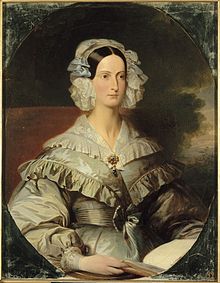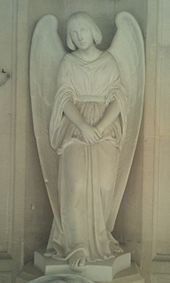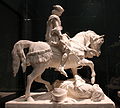Marie Christine d'Orléans
Marie Christine Caroline Adélaïde Françoise Léopoldine d'Orléans (born April 12, 1813 in Palermo , † January 2, 1839 in Pisa ) was a French king's daughter who became Duchess of Württemberg by marriage. Before her marriage, she worked as a sculptor and dedicated herself particularly to the subject of the Maid of Orléans .
family
Marie was the second daughter of the French royal couple Ludwig Philipp and Maria Amalia . On October 17, 1837, the Catholic princess married the Protestant Duke Alexander von Württemberg . Although her husband was merely the representative of a lesser sidelines of a German royal family, yet he was by means of his father Alexander Friedrich Karl of Württemberg a nephew of King Frederick I of Württemberg and his mother Antoinette of Saxe-Coburg-Saalfeld a nephew of King Leopold I of Belgium . Marie Christine had only one child, Duke Philipp von Württemberg , born on July 30, 1838 , who founded the Catholic line of the House of Württemberg and whose son Albrecht von Württemberg rose to head the entire house in 1921 and would have become King of Württemberg had it not been for 1918 November Revolution would have taken place.
biography

Marie Christine, who had been interested in literature and history since her youth, was a musically gifted princess, who wrote her own poetry and prose and was also active in the musical field and especially in the visual arts. As a student of the artist Ary Scheffer , she discovered her passion for sculpture. So she set up her own studio in the Tuileries Palace , where she modeled numerous works of art. Bronze casts of various statues of the Maid of Orléans in front of the house where she was born in Domrémy-la-Pucelle and in front of the town hall in Orléans are a reminder of Marie Christine's artistic work. As a representative of the nobility, it was still difficult for her to establish herself in the art world. Not much has survived of her artwork, most of which were lost to the looting of the Tuileries Palace during the 1848 Revolution .
In 1834 it was initially planned to marry Marie Christine to a younger brother of King Ferdinand II of both Sicilies . The King of the Two Sicilies gave his consent to marry Prince Leopold Benjamin of Syracuse (1813–1860), who, like himself, came from the second marriage of his father Franz I to Maria Isabel of Spain . Because of the unrest that arose in France in April 1834, the court of the two Sicilies in Naples made the wedding dependent on Marie Christine bringing her entire inheritance into the marriage in advance. An examination of this demand by the French court finally led to the end of the marriage project.
In 1837, on the initiative of the Belgian King Leopold, he married Duke Alexander von Württemberg. The wedding celebrations took place on October 18, 1837 in the Great Trianon in Versailles . The civil marriage was carried out by the French Chancellor Étienne-Denis Pasquier , the Catholic marriage by the Bishop of Versailles and the Protestant by Pastor Cuvier. During the following days, the French royal couple held a number of receptions on the occasion of the wedding.
Marie Christine was in mortal danger on a tour with her husband, who took her to the courts of German princes, when the palace in which the young man was burned down in Gotha - the residence of Duke Ernst I and Duchess Antoinette Marie , Alexander's sister Couple lived. This major fire in the middle of winter, which Marie Christine almost fell victim to, could perhaps have been the cause of the duchess's lung disease. Possibly the compromised health was further impaired by the birth of the son Philipp in the summer of 1838.
In the autumn of 1838, Duchess Marie Christine von Württemberg went to Italy with her young son in the hope that the milder climate would help her tuberculosis cure . However, she died of the effects of the disease shortly after the New Year in 1839 in the Palazzo Vitelli in Pisa. She was buried in the Chapelle royale Saint-Louis in Dreux , the burial place of the House of Orléans .
plant
Among the sculptural works of Marie d'Orléans are:
- The relief of the resurrection of the poet, French La Résurrection du poète , from 1834, the plaster original of which is preserved in the Musée Condé in Chantilly .
- The statue of the praying Joan of Arc , French Joan of Arc debout priant , from 1837. The marble original, of which numerous copies exist, is in the Palace of Versailles .
- The bronze version of this work on the platform of the Hôtel Groslot d'Orléans, the town hall of Orléans, was a gift from King Louis-Philippe I to the city of Orléans . It has holes and bumps, traces of the Second World War.
- The equestrian statuette of Joan of Arc weeping in the face of the wounded Englishman, French Jeanne d'Arc à cheval pleurant à la vue d'un Anglais blessé , which is in the Museum of Fine Arts in Lyon , in the wedding hall of the town hall of Orléans and in the Musée Condé in Chantilly can be seen.
Joan of Arc praying from Versailles , bronze cast on the enclosure in front of the Orléans town hall
Jeanne d'Arc on horseback weeping in the face of the wounded Englishman , Musée des beaux-arts Lyon
literature
- Sönke Lorenz, Dieter Mertens, Volker Press (ed.): The house of Württemberg. A biographical lexicon. Kohlhammer, Stuttgart 1997, ISBN 3-17-013605-4 , p. 406.
- Anne Dion-Tenenbaum: Marie d'Orléans. Princesse et artiste romantique. Somogy Editions d'Art, ISBN 978-2-7572-0165-7 - exhibition catalog for the exhibition of the same name in the Musée du Louvre (2008) and in the Musée Condé in Chantilly.
Web links
- Marie d'Orléans. Princesse et artiste romantique. 1813–1839 Reception of the exhibition of the same name at www.latribunedelart.com (French)
- Base Joconde of the French Ministry of Culture at www.culture.gouv.fr with a search function for other works by Marie d'Orléans
| personal data | |
|---|---|
| SURNAME | Orléans, Marie Christine d ' |
| ALTERNATIVE NAMES | France, Marie Christine Caroline Adélaïde Françoise Léopoldine of |
| BRIEF DESCRIPTION | French princess and duchess of Württemberg |
| DATE OF BIRTH | April 12, 1813 |
| PLACE OF BIRTH | Palermo |
| DATE OF DEATH | January 2, 1839 |
| Place of death | Pisa |





